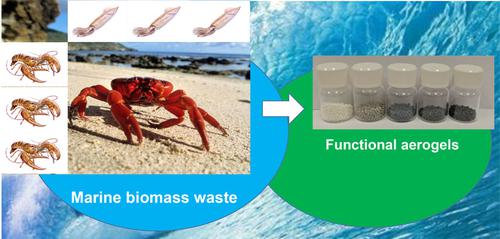当前位置:
X-MOL 学术
›
Chem. Rec.
›
论文详情
Our official English website, www.x-mol.net, welcomes your
feedback! (Note: you will need to create a separate account there.)
Green and Functional Aerogels by Macromolecular and Textural Engineering of Chitosan Microspheres
The Chemical Record ( IF 7.0 ) Pub Date : 2020-02-24 , DOI: 10.1002/tcr.201900089 Abdelkrim El Kadib 1
The Chemical Record ( IF 7.0 ) Pub Date : 2020-02-24 , DOI: 10.1002/tcr.201900089 Abdelkrim El Kadib 1
Affiliation

|
Tremendous interest was recently devoted to the preparation of porous and functional materials through sustainable route, including primarily the use of renewable biopolymers instead of petroleum‐sourced synthetic chemicals. Among the biopolymers available in enormous quantity, chitosan – obtained by deacetylation of chitin – stands as the sole nitrogen‐containing cationic amino‐sugar carbohydrate. This distinctively provides chitosan derivatives with plenty of opportunities in materials science. Particularly, its pH switchable solubility allowed the preparation of three‐dimensional entangled nanofibrillated self‐standing microspheres. These porous hydrogels behave as nano‐reactors to confine exogenous nanoobjects within the polysaccharide network, including sol‐gel metal alkoxide species, organometallic derivatives and isotropic and oriented nanoparticles. Besides, the interfacial interplay of chitosan with lamellar clay and graphene oxide allowed the penetration of the biopolymer inside of the galleries, which result in a complete delamination of the layered nanomaterials. The preserved gelation memory of chitosan in these formulations provides a way to access porous microspheres entangling exfoliated nanometric sheets. CO2 supercritical drying of functional hydrogel beads enabled efficient removal of water and other liquid solvents without wall collapsing, allowing large‐scale preparation of millimetric hydrocolloidal microspheres with an open macroporous network. These functionalized lightweight biopolymer aerogels find applications in heterogeneous catalysis, sensing, adsorption, insulation and for the design of other sophisticated porous nanostructures. Beyond their tailorable molecular and textural‐engineering, the possibility for macroscopic shaping of these intriguing nanostructures opens many new opportunities, especially in additive‐manufacturing for soft and hybrid robotics.
中文翻译:

壳聚糖微球的高分子和结构工程绿色和功能性气凝胶
最近,人们特别关注通过可持续途径制备多孔和功能性材料,主要包括使用可再生生物聚合物代替石油来源的合成化学品。在大量可用的生物聚合物中,通过几丁质脱乙酰化获得的壳聚糖是唯一的含氮阳离子氨基糖碳水化合物。这为壳聚糖衍生物提供了独特的材料科学机会。特别是,其pH值可转换的溶解度允许制备三维纠缠的纳米原纤化自立微球。这些多孔水凝胶可充当纳米反应器,将多糖网络中的外源纳米物体限制在其中,包括溶胶凝胶金属醇盐物种,有机金属衍生物和各向同性和取向的纳米粒子。此外,壳聚糖与层状粘土和氧化石墨烯的界面相互作用使生物聚合物渗透到通道内部,从而导致层状纳米材料完全分层。这些配方中壳聚糖的胶凝记忆力得以保持,为进入缠结剥离纳米片的多孔微球提供了一种途径。一氧化碳2对功能性水凝胶珠的超临界干燥能够有效去除水和其他液体溶剂,而不会使壁塌陷,从而可以通过开放的大孔网络大规模制备毫米水胶体微球。这些功能化的轻质生物聚合物气凝胶可用于多相催化,传感,吸附,绝缘以及设计其他复杂的多孔纳米结构。除了可定制的分子和纹理工程外,这些有趣的纳米结构的宏观成形还提供了许多新的机会,尤其是在软和混合机器人的增材制造中。
更新日期:2020-02-24
中文翻译:

壳聚糖微球的高分子和结构工程绿色和功能性气凝胶
最近,人们特别关注通过可持续途径制备多孔和功能性材料,主要包括使用可再生生物聚合物代替石油来源的合成化学品。在大量可用的生物聚合物中,通过几丁质脱乙酰化获得的壳聚糖是唯一的含氮阳离子氨基糖碳水化合物。这为壳聚糖衍生物提供了独特的材料科学机会。特别是,其pH值可转换的溶解度允许制备三维纠缠的纳米原纤化自立微球。这些多孔水凝胶可充当纳米反应器,将多糖网络中的外源纳米物体限制在其中,包括溶胶凝胶金属醇盐物种,有机金属衍生物和各向同性和取向的纳米粒子。此外,壳聚糖与层状粘土和氧化石墨烯的界面相互作用使生物聚合物渗透到通道内部,从而导致层状纳米材料完全分层。这些配方中壳聚糖的胶凝记忆力得以保持,为进入缠结剥离纳米片的多孔微球提供了一种途径。一氧化碳2对功能性水凝胶珠的超临界干燥能够有效去除水和其他液体溶剂,而不会使壁塌陷,从而可以通过开放的大孔网络大规模制备毫米水胶体微球。这些功能化的轻质生物聚合物气凝胶可用于多相催化,传感,吸附,绝缘以及设计其他复杂的多孔纳米结构。除了可定制的分子和纹理工程外,这些有趣的纳米结构的宏观成形还提供了许多新的机会,尤其是在软和混合机器人的增材制造中。











































 京公网安备 11010802027423号
京公网安备 11010802027423号